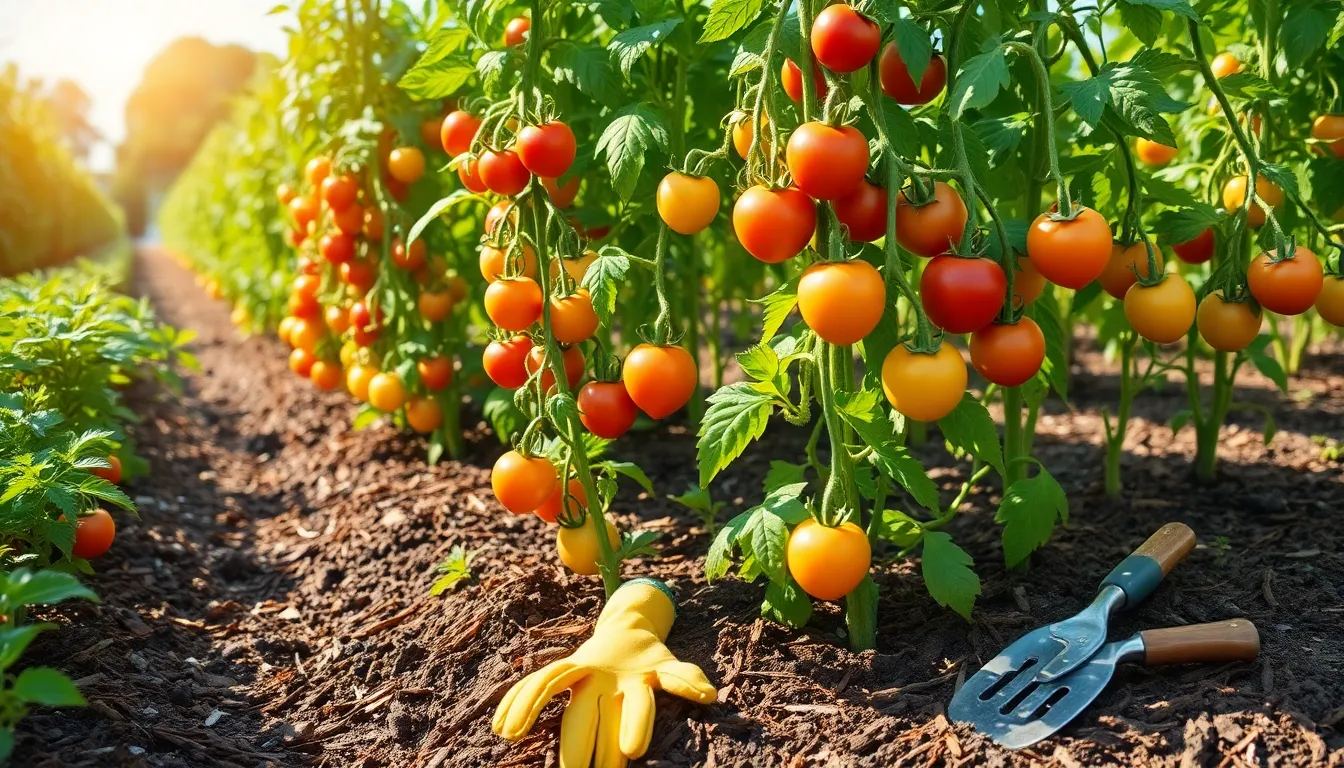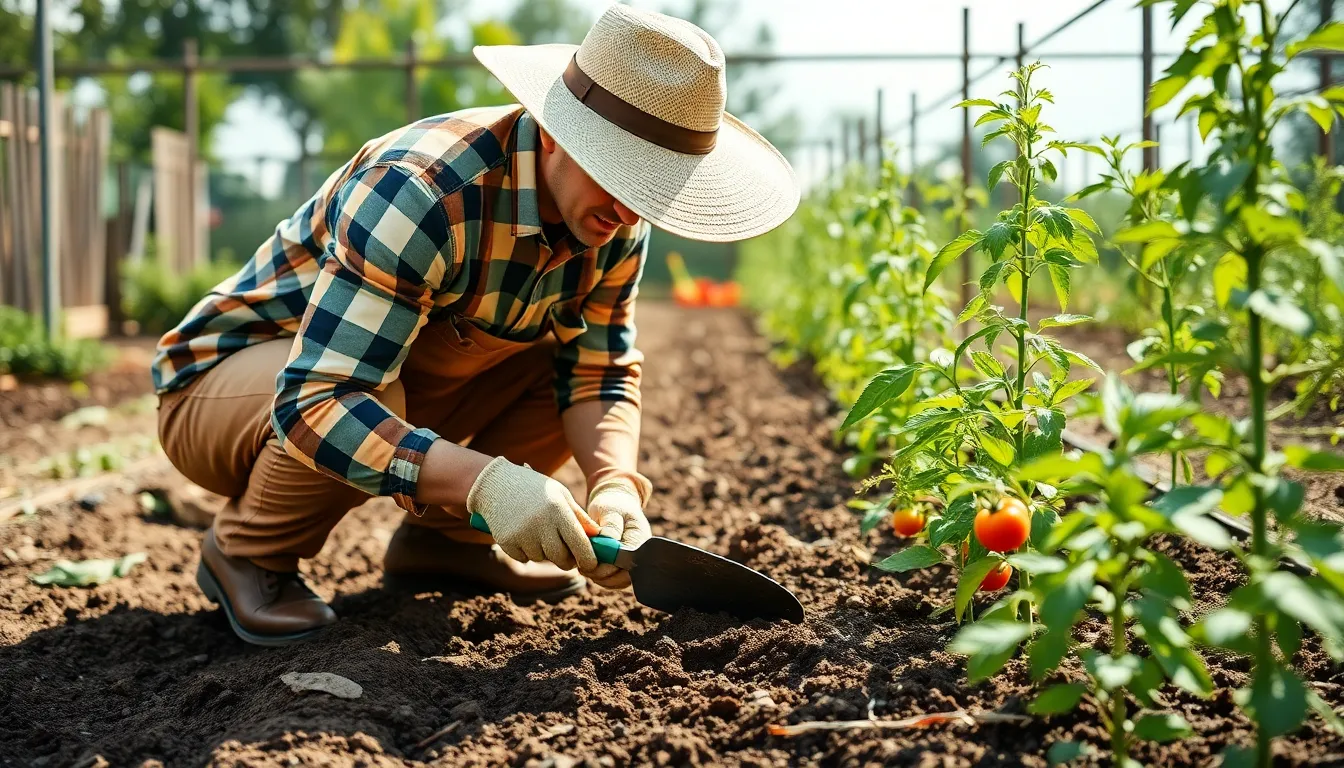Tips for Planting Tomatoes: Your Ultimate Guide to a Thriving Garden

Tomatoes are the rock stars of the garden world. With their vibrant colors and juicy flavors, they can elevate any dish from mundane to mouthwatering. But before those delicious fruits can grace your plate, they need a little TLC in the planting department. Whether you’re a seasoned green thumb or a newbie just trying to avoid turning your garden into a desert, mastering the art of tomato planting can make all the difference.
Imagine biting into a fresh tomato, bursting with flavor, that you grew yourself. Sounds dreamy, right? But hold on! Planting tomatoes isn’t just about tossing seeds in the ground and hoping for the best. It requires a bit of know-how and a sprinkle of patience. From choosing the right variety to understanding soil conditions, these tips will help you cultivate a thriving tomato garden that’ll have your neighbors green with envy.
Tips for Planting Tomatoes
Selecting the right tomato variety significantly impacts growth and yield. Gardeners must consider specific types to suit their climate and culinary needs.
Determinate vs. Indeterminate
Determinate tomatoes grow to a specific height and produce fruit in a concentrated time frame. They often require less support and are ideal for smaller gardens. Indeterminate varieties continue to grow and produce fruit throughout the season. Their sprawling nature typically necessitates staking or caging for support.
Heirloom vs. Hybrid
Heirloom tomatoes are open-pollinated and grown for generations, offering rich flavors and unique colors. Many gardeners prefer them for their taste and historical significance. Hybrid tomatoes result from controlled cross-breeding, often providing enhanced disease resistance and uniformity. These varieties usually mature faster, making them suitable for various climates.
Preparing the Soil

Preparing the soil is crucial for healthy tomato plants. Tomatoes thrive in well-drained, nutrient-rich soil.
Soil Quality and Composition
Soil quality significantly influences tomato growth. It should contain organic matter like compost or well-rotted manure, enhancing drainage and nutrient content. Sandy loam offers a balanced texture, allowing air circulation while retaining moisture. Adding aged compost improves soil fertility and structure, promoting healthy roots. Mixing in mulch can aid in temperature regulation and moisture retention. Regular aeration prevents soil compaction, ensuring roots access essential air and nutrients.
pH Levels and Nutrients
Maintaining optimal pH levels is essential for nutrient absorption. Tomatoes prefer a pH level between 6.0 and 6.8. Testing soil pH with a reliable kit provides baseline information for adjustments. Adding lime raises pH, while sulfur can lower it, balancing nutrient availability. Essential nutrients such as nitrogen, phosphorus, and potassium support overall plant health. Incorporating a balanced fertilizer can also enhance growth. Regularly monitoring nutrient levels helps ensure tomatoes receive necessary sustenance for robust production.
Planting Techniques
Proper planting techniques significantly influence tomato growth and productivity. Following a few guidelines ensures the best results.
Timing for Planting
Planting tomatoes requires careful attention to timing. Soil temperature must consistently reach 60°F for optimal germination. Late spring typically provides ideal conditions, as frost no longer poses a threat. In northern regions, aim for late May, while southern areas can begin planting as early as April. Seedlings should possess at least two sets of true leaves before transferring them outdoors. Late afternoon planting promotes adaptability, allowing plants to acclimate during cooler temperatures.
Spacing Your Plants
Effective spacing is crucial for healthy tomato plants. Individual plants need sufficient room to thrive, typically 18 to 24 inches apart, depending on the variety. Proper spacing facilitates air circulation, reducing the risk of disease. Rows should measure 3 to 4 feet apart, providing space for maintenance activities. Planting in staggered rows can maximize garden space while ensuring each plant receives adequate sunlight. Adjusting the spacing based on plant size will prevent overcrowding, promoting vigorous growth and increasing yields.
Watering and Care
Regular watering and proper care are vital for thriving tomato plants. Maintaining consistent moisture levels ensures healthy growth and abundant fruit.
Irrigation Methods
Drip irrigation provides targeted hydration directly to the roots, reducing water wastage. Soaker hoses deliver water along the soil’s surface, promoting even moisture distribution. Hand watering allows gardeners to monitor soil conditions closely, ensuring adequate hydration. Timing plays a key role; watering in the early morning minimizes evaporation while preventing disease. The goal remains to keep the soil consistently moist, especially during flowering and fruiting stages.
Mulching for Moisture Retention
Using mulch effectively conserves moisture and suppresses weeds. Organic materials like straw or wood chips break down over time, adding nutrients to the soil. Applying a 2 to 4-inch layer helps regulate soil temperature, providing a stable environment for roots. Gardeners should ensure mulch stays clear of plant stems to prevent rot. Replenishing mulch as it decomposes keeps moisture levels optimal throughout the growing season.
Pest and Disease Management
Managing pests and diseases is crucial for healthy tomato plants. Effective strategies can prevent yield loss.
Common Pests to Watch For
Aphids, small sap-sucking insects, can weaken tomato plants. Spider mites thrive in dry conditions and cause stippling on leaves. Whiteflies pose a threat too, as they can transmit viral diseases. Additionally, hornworms are voracious caterpillars that can devour foliage quickly. Detecting these pests early prevents significant damage. Regularly inspect plants for any visible signs of infestation.
Preventative Measures
Implementing preventative measures enhances plant health. Proper spacing allows for air circulation, reducing humidity that pests prefer. Using row covers protects plants from insect invasions. Additionally, rotating crops each season helps break pest life cycles. Introducing beneficial insects like ladybugs provides natural pest control. Neem oil also serves as a natural pesticide when applied regularly. Maintaining a clean garden environment minimizes disease risk.
Conclusion
Growing tomatoes can be a rewarding experience that adds flavor and vibrancy to any garden. By selecting the right varieties and preparing the soil properly gardeners set the stage for success. Consistent care including proper watering and pest management ensures healthy plants and bountiful harvests.
With attention to detail and a bit of patience anyone can enjoy the satisfaction of cultivating their own delicious tomatoes. Whether it’s a small patio garden or a larger plot these tips can help maximize growth potential and yield. Embracing these practices will lead to a flourishing tomato garden that delights the senses.



